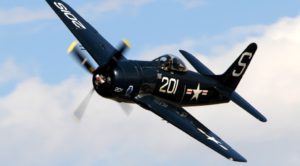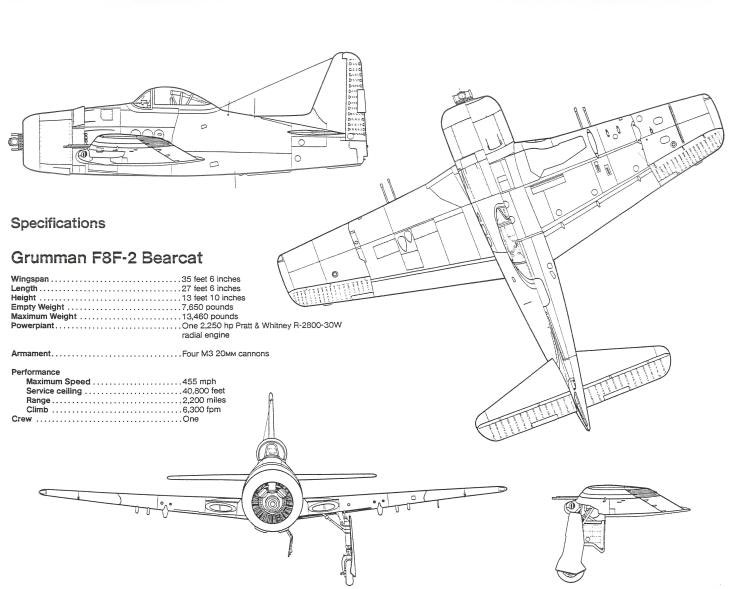GRUMMAN F8F-2 “BEARCAT” NAVY FIGHTER Bu No. 122674; #N7825C
Specifications F8-2 Bearcat
General characteristics
Crew: 1 pilot
Length: 28 ft 3 in (8.6 m)
Wingspan: 35 ft 10 in (10.9 m)
Height: 13 ft 10 in (4.2 m)
Empty weight: 7,070 lb (3,210 kg)
Loaded weight: 9,600 lb (4,400 kg)
Max takeoff weight: 12,947 lb (5,870 kg)
Powerplant:
1× Pratt & Whitney R-2800-34W “Double Wasp”
two-row radial engine, 2,100 hp (1,600 kW)
Performance
Maximum speed: 421 mph (366 knots, 680 km/h)
Range: 1,105 mi (1,780 km)
Service ceiling 38,700 ft (11,800 m)
Rate of climb: 4,570 ft/min (23.2 m/s)
Power/mass: 0.22 hp/lb (360 W/kg)
Armament
Guns: 4× M3 20 mm cannons
Rockets: 4× 5 in (127 mm) unguided rockets
Bombs: 1,000 lb (450 kg) bombs
In July 1943 Roy Grumman proposed to develop a small fighter plane which could be used on large or small carriers, with a performance superior (in every way) to the F6F. The unsolicited proposal to BuAer got immediate attention. A fast climbing piston-powered fighter was one of their highest priorities because the Japanese were expected to introduce fighters with performance that was much improved over the Zero.
The subsequent Bearcat design had the largest reliable engine available at the time (P&W R-2800) fitted to the smallest possible airframe. Some pilots likened it to “an engine with a saddle!” This was the same design philosophy behind the famed Gee Bee (Granville Brothers) racers. Test pilot and aircraft designer R.L. (Bob) Hall was involved in the development of both.
The Bearcat, smaller than the Wildcat (2.5 ft shorter wingspan; 1 ft shorter length) and more powerful than the Hellcat, was first flown on 31 Aug 1944 by Bob Hall. The last Bearcat was delivered 14 Apr 1949. A total of 1263 F8Fs were built, plus two civilian aircraft (Grumman design G-58A).
There were three basic variants of the Bearcat. Early F8F-ls were fitted with four 50-cal machine guns, late F8F-ls and all -2s had four 20 mm cannon, and the -2Ps had two 20 mm cannon in addition to photo equipment. The -2s had one-foot taller vertical tail surfaces for better longitudinal stability, automatic engine control, dive recovery flaps, and a higher hp engine. The -2N operated briefly as an unsuccessful night-fighter; the externally wing-mounted radar adversely affected performance.
Standard features were sacrificed in order to reduce weight: fewer guns, less fuel, and no adjustable seat. Seat adjustments were made with cushions. Once extended, the tailhook stayed that way until flight-deck crewmen muscled it back. The outer 6 feet of the wings were folded manually in a simple upward-fold, unlike the “stow-wing” style used on other Grumman aircraft. On a flight deck, 50 F8Fs fit in the space taken by 36 Hellcats. The full-blown bubble canopy was a first for Navy fighters.
The outboard 3 feet of each wing was designed to break away if the wings were overstressed, thereby preventing catastrophic failure of the entire wing structure. Explosive bolts would automatically discard one wing tip if the other wing was broken off by stress. These “Safety Wing Tips” were not as safe as expected, and were eliminated after some fatal accidents. Several pilots shed their wing tips and augered in during dive-bombing pullouts; others had wing tip blow-offs during carrier landings, injuring deck crewmen.
Bearcat-equipped VF-19 was aboard the USS Langley enroute to the western Pacific when the war ended. Although too late to see combat with the US Navy, 24 squadrons were flying the Navy’s “hot rod” by the end of 1948. Bearcats later saw service in Indochina with the French.


